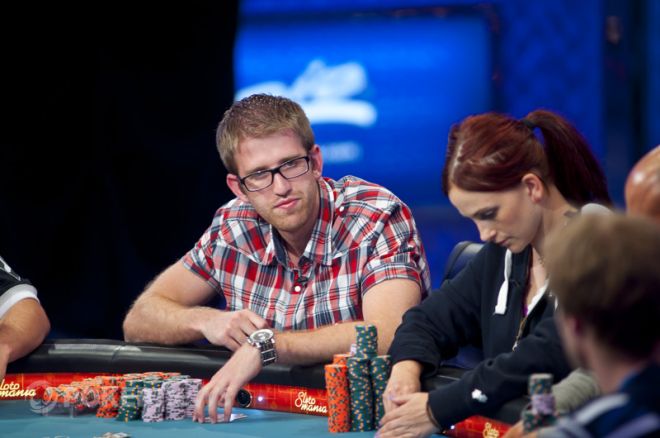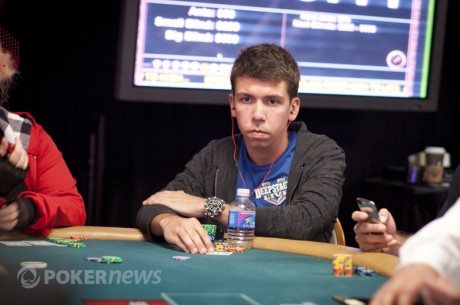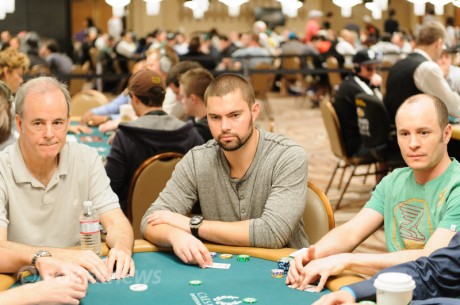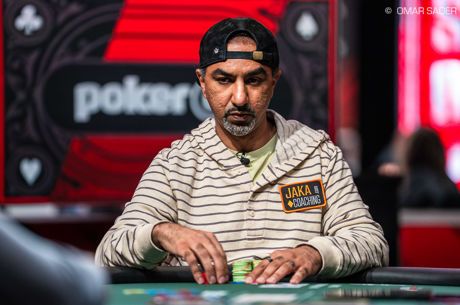Russell Thomas Discusses Bet Sizing and Aggression Strategy for WSOP Ante-Only Event

On Tuesday, the World Series of Poker presented one of the newest forms of tournament poker, ante-only no-limit hold��em, for the second straight year.
For those unfamiliar with the newly-created format, an ante-only event is played out much like a regular tournament with one major twist �� instead of a small blind and a big blind, there are, as the name suggests, only antes. That means each and every player at the table will post an ante at the start of each hand, with the ante increasing exponentially throughout the tournament.
The preflop and postflop betting begins with the player to the left of the button, with the button moving around the table just like a regular tournament. The first player to act will have two options �� to either fold or start the betting (bring-in) with the smallest denomination chip posted for each level. That means while the 25-denomination chips are in front of them, the betting can be as low as 25 �� even when the ante is 75 as late as six levels into the day. Of course, the event is no-limit, so there is no maximum to what a player can bet.
Last year, Greg Hobson defeated a field of 939 players in the inaugural $1,500 buy-in event to collect $256,691 along with his first WSOP bracelet. Tuesday��s event attracted top pros like Hobson, Matt Salsberg, Matt Berkey, Brent Hanks, Allen Cunningham, and Russell Thomas.
Thomas is best recognized as a member of the 2012 WSOP Main Event final table. No stranger to poker, he is a friend of 2012 Main Event runner-up finisher Jesse Sylvia, as they roomed together in Vegas during that time. Thomas also has some online poker accomplishments to his list of successes, and though he hasn��t participated in many live tournaments, he has done exceptionally well. With only nine live cashes since 2010, Thomas has earned over $3 million in lifetime earnings.
Known to be an advanced thinker in poker, we thought it would be a good idea to ask Thomas for some advice about how to approach the ante only-event. Here��s what he had to say.
PokerNews: Is limping more common in ante-only events?
Thomas: It��s absolutely more common because you are getting much better odds to limp than you are in a normal tournament. In a normal tournament you have to call a big blind, which is actually a lot of chips relative to the pot. In an ante only there is eight antes in the pot and sometimes you can call for less than an ante so you get much better odds to limp in.
How do you calculate your bet sizing?
I look at how much is in the pot to start. Then I decide on the size somewhere between half pot and three quarters pot. The reason I like it around there is because you still get a good amount of folds and it gives you really good odds to steal the antes. It��s typically a good size overall I think.
Can a tight player run deep in an ante only event?
I think they have a much tougher time but it is slightly possible. I think a lot of people are making big mistakes by not playing enough hands. They should be limping more. When it is limp, limp, limp and you are on the button you shouldn��t be folding and instead limping with any two cards. Seven-four offsuit you should be limping in, no questions asked.
Does this format cater to more of a loose-aggressive (LAG) player?
I think so. It caters to people who are really thinking about the game theory. You have to change the way you think. You can��t just decide to play the top 20 percent of hands. You have to play all of your hands in a lot of different spots.
You mentioned that you limp a lot more. Let��s say you have premium hands like ace-king, kings, aces, queens, etc. Are you still limping with these holdings?
It depends on the position I am in. I will be limping with these hands sometimes but it depends on who is behind me. Some people raise a lot when it folds to them, so in that case I will be limping a strong hand. I haven��t actually had any strong hands to limp with in the tournament but that��s what I would be doing typically. In other spots, like if I am on the button, I will be raising.
Is post-flop creativity more important than preflop play?
No I would say preflop play is the most important in these ante-only tournaments. A lot of pots go six-way and you don��t really need to get that creative postflop; you just need to make good preflop decisions to get yourself in spots where you can flop top fair and show profit.
When is a good time to start shoving all in preflop?
Initially you want to calculate the size of the pot. So if there is 450 in the pot, then you want to shove when you have maybe like five-times the pot. I think that is a good stack to be shoving. At most, it should be five or six times the pot.
Is there less of an incentive to play from the blinds?
Since there aren��t any blinds but still in the earliest position of the table, you still want to try to play more in the later positions. I think you still show a profit by limping in with a lot of hands even from the blinds. My last table there was a player in late position who kept reraising every time it folded to him. In that case, I did fold a couple of hands from early position but I did also limp reraise a couple of times also.
Does position become less or more important since you limping from any spot on the table?
I don��t know if it��s more important than normal. Position is key in any form of poker. In ante only since you are limping more often and get raised, you definitely don��t want to get caught playing garbage out of position. However, if you have a great starting hand limp calling or check calling out of position can be helpful in some cases.
Is it true to say if you are on a tight table then you should play more loose and if you are on a loose table you should play tighter?
It depends. I would say even at a loose table you should probably be playing pretty lose because you shouldn��t be folding many hands when all you have to do is call the ante and there is something like 450 in the pot. Against a table that is very aggressive and players are constantly reraising and three betting, then maybe you can play tighter. Even then, you are still usually getting pretty good odds to be calling raises and three bets.
Can you give an example of a way to trap an aggressive player?
When there are a couple of limps under the gun and it folds to you in middle position, while you have a pretty good hand then you can limp. It��s probable that when it folds to late position that someone will raise it up. If you hit a strong board then it's very possible the raiser won��t believe you. Most people automatically think if you have a big hand that you would have raised preflop instead of just limping, which isn��t necessarily true. That��s usually a good spot to try to trap someone.
In what scenario is three-betting okay to do?
When a player consistently raises to try to pick up the antes over a bunch of limpers. A lot of players will raise a third of the pot, which gives them very goods odds to steal the antes because it only needs to work about once every four times or so. But at that point you can three-bet them.
You tweeted that a lot of players were ��misplaying this tournament.�� Can you give examples of leaks you saw on the tables?
I saw a player who had a huge stack and seemed very competent of the game make mistakes. The action would run limp, limp, limp and he would fold on the button. I don��t think you should be doing that when there is 450 in the pot with three limpers. You are calling 25 to win a pot over 500 and in position. That��s just a huge mistake.
You also tweeted that you limped reraised to five-bet with king-five offsuit. What made you comfortable to run that move?
The other player had a big stack. He was a player that every time it folded to him or there were a few limpers while he was on the button, he would just bomb it for a pot-size bet. He decided to raise to 600 after I limped with king-five offsuit. I decided to limp-reraise him because I had been limping a lot and folding so I thought I could get him to fold based off the image I created. Plus, his bet sizing gave me some indication that he was maybe weaker than he was trying to portray. So after he raised to 600, I reraised to 1,500, and he four-bet to 2,500. There��s not a lot of hands that he would be happy getting it all in with so I was sure he didn��t have a big hand. I then made it 4,200 and he folded. That was definitely more of reading the player rather than reading my hand.
Be sure to follow our Live Reporting page for continuing coverage of every event at the 2013 World Series of Poker, and follow PokerNews on Twitter for up-to-the-minute news.








